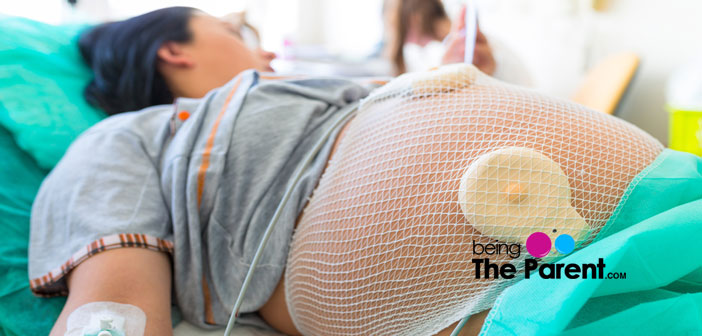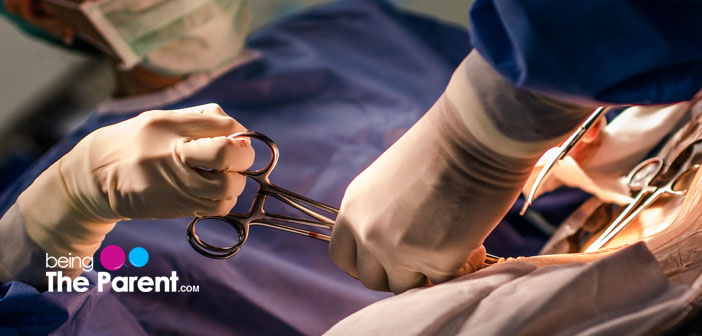Millions of women enjoy a risk-less normal pregnancy and give birth to healthy babies. However, not all women are blessed or lucky enough to experience smooth deliveries. There is a hand full of complications that can happen in the course of pregnancy and childbirth, some of which may pose dangers to the mother and the child. Uterine rupture is one among them.

What Is A Uterine Rupture?
Uterine rupture is a really uncommon and unpredictable event, an emergency condition, which usually takes place in the course of labor, which has a devastating effect on both the mother and the baby. A uterine rupture is a tear that happens at the wall of the uterus, most often in the region where a past C-section incision has been made. Basically, it can be said that a previous cesarean section tears open. In a complete rupture, the scar opens fully along its length and every one of the three layers [perimetrium (outer), myometrium (middle), and endometrium (inner)] of the uterus. Mostly, the rupture of the amniotic sac, which holds the baby in the amniotic fluid medium, follows a uterine rupture. Thereby, there is an increased chance for the baby and the placenta to penetrate into the abdominal cavity via the ruptured uterine wall. This can bring about serious bleeding in the mother and can choke out the child.
Even though more often than not it is associated with labor, uterine ruptures are also found to occur in the course of gestation.
What Are The Chances Of Uterine Rupture?
As we already specified, fortunately, the condition of uterine rupture is an extremely rare condition. Still, the possibilities are not low. Most often, uterine ruptures happen in the previous C-section scar. One in three women nowadays is giving birth by means of C-section. This implies that considerable amounts of women are going into their next labor with a uterine scar. This makes the possibilities of uterine rupture high. Likewise, uterine rupture is the main worry, while planning a VBAC (which also places restriction around the way and time span they can try for the vaginal delivery).
Irrespective of this statistic, let us find why uterine rupture is considered as an extremely rare issue.
- Uterine rupture in an unscarred uterus happens only six in every ten thousand deliveries (6/10,000)
- The chances of uterine rupture in scarred uterus are (merely) in between 20 to 70 in every ten thousand deliveries (20-70/10,000)
- Only around 6 babies out of hundred, whose mother experienced uterine rupture, are not able to make it
- Just around 1 mother out of hundred die from the complications that arise due to the uterine rupture
Therefore, uterine rupture when diagnosed and treated properly, the odds are very low for complications develop that jeopardize the life of mother and baby.
What Causes Uterine Rupture?
Uterine rupture can happen to both scarred and unscarred uterus. During labor, pressure increases as the baby moves through the mother’s birth canal. Basically, this pressure is the main culprit in causing the uterine rupture. A uterus being traumatized by an accident during pregnancy can lead to spontaneous rupture of the uterus. An accident that resulted in a permanent damage or weakening of the uterus prior to pregnancy can also end up in rupture as the weakened uterus may not be able to stand the pressure.
Do All C-section Scars Possess Danger Of Uterine Rupture?
There are three types of C-section incisions, with the fourth one coming into picture rarely:
- Low transverse incision: This type of incision is more common. Cut through the lower fibrous part of the uterus
- Low vertical incision: When the baby is in breech position, this type of incision is made by the doctor for safe delivery. It is a vertical cut put on the lower half of the uterus
- Classical incision: It is a vertical cut put on the upper half of the uterus. It is done when the baby is premature and the uterus is not stretched enough to perform low transverse incision, or if the baby lying cross-way. It is a rarely done incision, only if the circumstances demand as it is accompanied by major blood loss
- T or J incision: This type of incision is usually done as a result of the low transverse incision suddenly being not enough to deliver the baby. Extending the incision to T or J shape will make the delivery easier. If the baby is in an unusual position, for a safe delivery, the doctors will be forced to put a T or J incision
Coming to the risky scars, the classical scar poses a high risk of rupture as more muscular parts are involved. All the vertical scars are more prone to rupture. Therefore, mothers with a vertical T or J scar possess more risk of uterine rupture. A low transverse uterine incision is safe, especially if you had only one C-section previously. Otherwise, the chances are very very low for the low transverse incision to rupture as mostly the fibrous tissues are involved.
Is It Possible For An Unscarred Uterus To Rupture?
Yes. Uterine ruptures are found to occur among some women who have never had a C-section. This sort of rupture happens as a result of:
- Weakening of the uterine muscle after several pregnancies and deliveries (more than four)
- An earlier surgical procedure in the uterus like the removal of a fibroid, curettage (remove uterine tissues by means of scraping or scooping), abortion, etc.
- Too much use of labor inducing medication such as oxytocin or prostaglandins, which give rise to frequent and forceful contractions
- Prolonged labor with a big sized baby

What Is The Uterine Window?
The uterine window is a common name for asymptomatic separation or incomplete ruptures. Here, the uterine wall becomes so thin that the baby can be seen through the thinned uterine muscle. Hence, it is called “uterine window”. This happens as the outer layer of the uterine wall, the perimetrium, stays undamaged, but the underlying layers (myometrium and endometrium) tear. Uterine windows can in due course develop into uterine rupture.
What Are The Signs Of Uterine Rupture?
Several signs have been noticed prior to uterine rupture. However, all these signs do not necessarily happen with every uterine rupture. Uterine rupture is mostly accompanied with some of the following signs:
- An abnormal heart rate of the baby (that is why the baby is monitored full time during VBAC)
- Sudden sharp pain in the area of the previous scar
- Baby’s head starts moving upward instead of going down the birth canal
- Uterine atony, a condition in which the uterus loses its muscle tone
- Abnormal abdominal pain
- Too much vaginal bleeding
- Pain in the chest and rapid heart rate due to internal bleeding
- The baby’s head appears to bulge under the pubic bone. This points out that the baby is outside the uterus
- The contractions start to slow down and sudden pain appears during the contraction
What Puts Me At A Risk For Uterine Rupture?
As we already discussed, those who undergo a C-section in the previous deliveries are more prone to uterine rupture. The more the number of C-sections a woman has, the higher chances of rupture. The risk also increases, if the expecting mothers experience:
- Hydramnios, a condition with excess amniotic fluid
- Placenta percreta (a condition in which the placenta penetrates through the uterine wall and attaches itself to nearby organs) or placenta increta (the condition in which the placenta penetrates deeply into the uterine wall)
- Multiple pregnancy
- If the mother is above 35 years old
- Previous history of uterine rupture
- If the ultrasound scan performed during the later stages of pregnancy indicates, the scar area has thinned below 2.5 mm
How Is A Uterine Rupture Treated?
Once the uterus ruptures, it is impossible to undo it. Immediate delivery through C-section is the only remedy. If substantial damage happens in the uterus due to rupture, the bleeding will be uncontrollable and the uterus will be irreparable. Therefore, in such cases, the doctor will proceed with a hysterectomy (removing the uterus). On the other hand, if the doctor manages to deliver the baby with minimal damage to the uterus, it can be fixed. However, as there will be lots of blood loss, the mother will likely need a blood transfusion.
Can Uterine Rupture Be Prevented?
Unfortunately, uterine rupture cannot be predicted with accuracy. Even though with the help of an MRI scan thickness of the scar and the wall can be measured, it does not yet count as a standard practice. Hence, prevention is impossible. However, choosing an apt pregnancy method, by reviewing medical history and risk factors, will help to decrease the chances of uterine rupture. Avoiding pregnancy within 2 years of a previous C-section will also help to minimize the risk of uterine rupture. Putting a double layer of suture rather than a single layered one helps to reduce the chances of uterine rupture in the succeeding deliveries.

